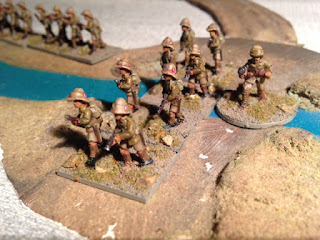I was setting up for my second game of Great War Spearhead II (GWSH II) with the aim of playing the "A Hot Day's Work" – a tasty little introductory scenario from Robin Sutton's The Great Adventure. This provides another hypothetical rearguard action by the BEF during the Great Retreat of 1914 – this time with a few more troops on each side and the lack of a bridge over an impassable river to focus one's defence on!
I was ready to go when, on rereading the scenario background, I saw that the BEF could start the game entrenched. 'But you don't have any entrenchment markers!', I hear you say.
I've always ben rather keen on the foxholes and trench markets produced by Timecast. So, I thought I'd have a go at something similar and decided to use card bases and form the trenches using caulking compound.
Here's a quick step by step:
 |
| Add a blob of acrylic caulking compound to each 30 x 30 mm (1.1/4") square of thick card. |
 |
| Wet your fingertip (stops it sticking) and smooth it out over the base. Then sprinkle a strip of flocking either side while wet - be careful to leave the centre clean. |
 |
| When the caulk is touch dry (20 minutes on a warm day) wet the template and press it into the caulk. Be sure to press each section down firmly - I used a screwdriver blade. |
 |
| Gently lift out the template. You have a passable trench impression. I then went over each with a palate knife and reshaped the caulk and scratched it away down to the card on the trench floor. |
 |
| Here they are in action (well... abandoned!). As I say, some detailing will take them the next step. |
For a quick job, I feel they make a passable trench marker. The template produced a rather deep traverse between each fire bay but for a quick job, I can put up with that.
How did the game go, I hear you ask? The aim for the British was to defend the village in the centre of the board.
 |
| The German commander executed a cunning flank march and swept in on the British left. |
.




















































